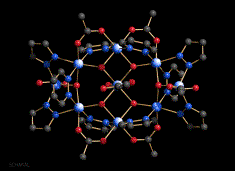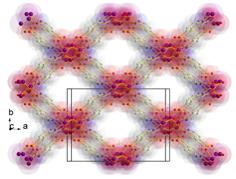
University Associate Professor

Our research is focused on the synthesis and characterisation of new materials, primarily using solvothermal synthesis. In this technique, reactions occur in solvents at temperatures above their normal boiling points by containing the reaction mixture within a pressure vessel. We have found this method to be particularly good for preparing porous materials for hydrogen storage and gas separation as well as new magnetic materials. We have an extensive range of collaborations with groups in the UK, the rest of Europe and in South Korea for performing measurements on the magnetism and porosity of our compounds.

- Magnetic materials are being prepared as part of the search for 'single molecule magnets' which represent the ultimate in magnetic data storage efficiency. We are also preparing compounds with which physicists can test theoretical models of magnetic behaviour; the same theories can be applied to other types of symmetry breaking in areas as diverse as protein folding and the early universe.
- New porous materials are much sought-after for gas storage in a future hydrogen economy. This is a very active area of research as zero-emission fuel sources are very attractive. Such materials could also be used as size- and shape-selective catalysis as well as gas separation and materials. The 'metal-organic framework' materials prepared in our lab are some of the most efficient hydrogen storage materials yet measured.
Publications
Possible strong symmetric hydrogen bonding in disodium trihydrogen bis( 2,2′-oxydiacetate) nitrate
Acta Crystallographica Section E: Crystallographic Communications
(2005)
61
m1174
(doi: 10.1107/S1600536805014819)
Novel coordination networks of 3D-metals with organothiolate ligands.
ABSTRACTS OF PAPERS OF THE AMERICAN CHEMICAL SOCIETY
(2005)
229
U1107
Water-soluble hydroxyalkylated phosphines: examples of their differing behaviour toward ruthenium and rhodium.
Dalton transactions (Cambridge, England : 2003)
(2004)
4202
(doi: 10.1039/b411701h)
Multiple areas of magnetic bistability in the toplogical ferrimagnet [Co-3(NC5H3(CO2)(2)-2,5)(2)(mu(3)-OH)(2)(OH2)(2)]
J Am Chem Soc
(2004)
126
13236
(doi: 10.1021/ja046351l)
The preparation and characterization of binary phosphorus–selenium rings
Heteroatom Chemistry
(2004)
1
351
(doi: 10.1002/hc.520010502)
Syntheses, structures and magnetic properties of Mn( ii ) dimers [CpMn(μ-X)] 2 (Cp = C 5 H 5 ; X = RNH, R 1 R 2 N, C[triple bond, length as m-dash]CR)
Dalton transactions (Cambridge, England : 2003)
(2004)
3481
(doi: 10.1039/B409135C)
Hydrothermal synthesis and magnetic properties of novel Mn( ii ) and Zn( ii ) materials with thiolato-carboxylate donor ligand frameworks
Journal of the Chemical Society. Dalton Transactions
(2004)
4
1670
(doi: 10.1039/B401887G)
Hydrothermal Synthesis of Microporous Transition Metal Squarates: Preparation and Structure of [Co3(μ3-OH)2(C4O 4)2]·3H2O
Angewandte Chemie International Edition in English
(2003)
36
991
(doi: 10.1002/anie.199709911)
2,2′-Disulfanyldibenzoic acid
Acta Crystallographica Section E Structure Reports Online
(2003)
59
o1364
(doi: 10.1107/S1600536803017306)
Applications of manganocene in the synthesis of Mn( ii ) amide and imide cages
Dalton Transactions
(2003)
3002
(doi: 10.1039/b303727b)
- ‹ previous
- Page 5

